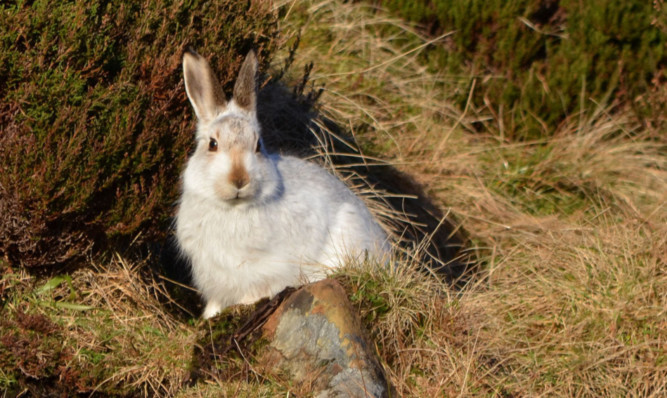A joint initiative aimed at suspending large-scale culls of mountain hares has been launched.
Working together, Scottish Natural Heritage (SNH) Scottish Land and Estates (SLE) and the Game and Wildlife Conservation Trust (GWCT) aim to ensure future management is sustainable.
Ron Macdonald, SNH’s director of policy and advice, said: “We are asking estates for restraint on large-scale culls of mountain hares which could jeopardise the conservation status of mountain hares.
“We recognise that some culling is occasionally needed to ensure healthy grouse stocks, but available evidence shows that large-scale culls of mountain hares are only effective when other tick-carrying animals are removed, or there is an absence of them in the area.
“Where such animals are not removed, we urge that hare culls should not be undertaken.
“We do not support large-scale culls, and we will work with estates to put in place effective but sustainable management of mountain hares.”
Along with red deer, mountain hares act as hosts to ticks which can in turn infect vulnerable grouse chicks with louping ill, causing widespread fatalities.
Adam Smith, director (Scotland) of the Game and Wildlife Conservation Trust, said: “We want to ensure that the strong positive relationship between mountain hares and management for red grouse continues.
“The shooting of mountain hares on Scottish moors can be done sustainably, and under certain conditions more intensive culls may be appropriate as part of a package of actions to sustain moorland management.
“However, moorland managers should carefully assess the need for and impact of their actions on their own and neighbouring hare populations, and regularly reassess this management.
“A contributory part of refining this adaptive approach to management is finding practical ways to assess hare abundance with greater accuracy.”
SNH has also joined forces with the James Hutton Institute (JHI) and Game and Wildlife Conservation Trust to begin a three-year joint study to trial several methods of assessing mountain hare population densities to determine the number of hares in a particular area.
Mountain hare populations are under threat from habitat loss, fragmentation and, in some areas, from large, local culls on grouse moors. Although not a fully protected species, the UK is obliged to ensure that the status of hare populations is not threatened in any way.
The project will develop a reliable and cost-effective field method that can be used to form the basis of a longer-term monitoring programme for the first time.
This is intended to lead to a better understanding of how hare populations are faring at both local and national scales, and to better-informed decisions about their sustainable management.
Currently most of the information on hare population trends is drawn from reports to GWCT about the number of hares shot on estates.
The last national estimate, published in 1995, suggested that there were 350,000 mountain hares in Scotland, but this estimate had error margins of plus or minus 50%.
The new project will trial various methods to identify the most suitable way of counting hares, with the objective of making reliable estimates of population density.
One of the aims of the study is to develop a method which does not rely solely on scientists but uses methods that could be collected by people working in the uplands.
Scott Newey, research scientist with JHI, said: “As leaders in field research on mountain hares, we at the James Hutton Institute welcome this initiative.
“We believe reliable and easy to obtain estimates of animal abundance or density are key to their sustainable management.
“This is challenging for mountain hares because methods need to be tailored to the species and their various habitats.
“This project aims to develop methods that can be used by all land managers to estimate mountain hare numbers in upland areas of Scotland.”
Ron Macdonald added: “This new study will lead to an improvement in the quality and quantity of information available on mountain hares in Scotland.
“We know there are genuine concerns about the state of mountain hares in Scotland, and this study will help us better understand the impact of land management on hares.”
Both the GWCT game bag data and independently-collected information on hares from breeding bird surveys by the British Trust for Ornithology indicate that mountain hare numbers have declined between 1995 and 2009.
When combined, these data give a statistically significant decline of 28%, although care is needed when interpreting this sort of data for species like mountain hares because they show natural population fluctuations which may make it difficult to interpret overall population trends.
The total cost for the four-year project is £314,644 with SNH contributing £235,949, the James Hutton Institute and GWCT £72,417, and GWCT contributing £6,278 in kind.
